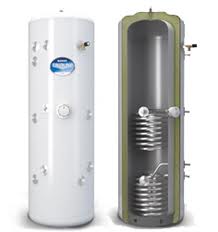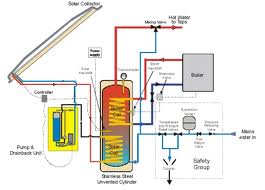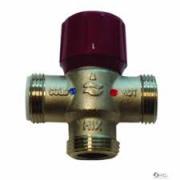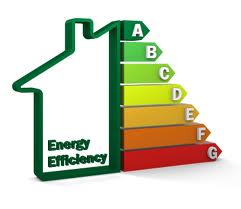This article on storing solar hot water following on from my article on solar water heating, I hope it helps answer any of the questions that you may have
In most homes, a standard hot water cylinder would usually be found in your airing cupboard. Within the cylinder there is usually a single metal coil (‘heat exchanger’) through which hot water from the boiler circulates and which in turn heats the water in the cylinder the required temperature.
When the water in the cylinder does not flow through the boiler, it is called an ‘indirect’ system.
Dual coil cylinder
Storing Solar Hot Water

In the UK the most common solar system we use replaces a standard cylinder with a twin coil cylinder, with one coil is located above the other. With the twin coil system the top coil is connected to the boiler and the bottom coil is connected to the solar collector
Another method that is used is for a dedicated single-coil cylinder to pre-heat the existing cylinder. As both of these systems use a coil heat exchanger they are known as ‘indirect’ solar systems.
When storing solar hot water a solar system will work best when the cylinder water is relatively cool. This in turn makes the use of large cylinders more effective.
In this way the solar heating system is always heating the water at the bottom of the cylinder which means that it is always the cooler water that is being heated first.
Solar heating advice
It is best that your boiler or immersion heater should be set to top up the heat first thing in the evening after the solar system has done its job during the day.
This water can then be used later on in the evening or the following morning. In turn this should mean that on a warm day, you might not need additional top up from your boiler or immersion heater.
In most modern solar panels they will have a controller monitoring the fluid temperature in the collector. As soon as it detects there is enough spare heat available a pump automatically switches on and the heat from the panel is transferred your hot water cylinder using the heat exchanger in the cylinder.
Integrating with existing heating systems

Solar heating system diagram
To be able to make the most of the available solar energy for storing solar hot water you will need to be able to store the energy collected as heat. From between the time, it is collected and the time you use it, the best method of doing this is to store the heat in a hot water cylinder.
If you currently have a conventional boiler and a hot water cylinder, then installing a solar system is usually just a case of fitting the panels and associated pipe-work and then replacing the existing hot water cylinder with a twin coil or connecting a separate pre-heat tank to the existing cylinder.
Has your home a combination (‘combi’) boiler?
If your home has a combi boiler then you will not currently have a hot water cylinder. It may be possible to add a hot water cylinder to your system at some point. If this is the case you can install solar panels feeding into that cylinder.
It is important that you check with your boiler manufacturer to find out if this is possible all good Norwich plumbers will be able to advise on this. If it is possible, you should make sure that your installer follows the manufacturer’s guidance on how the system should be installed.
It should be noted that if it is not possible to add a hot water cylinder, then you cannot install solar water heating without replacing your current boiler. All good Norwich plumbers will be able to discuss how storing solar hot water can be best achieved.
Advantages and Disadvantages

Important thing to remember when fitting a solar system
Collectors
• Performance – You should check that a system’s thermal performance has been
tested independently to BS EN 12975 or BS EN 12976 standards.
• Type – Flat plate collectors have a tendency to have a lower operating efficiency than evacuated tubes so will need a larger surface area, but could still be cheaper.
• Size – Collectors should be sized to at least 2m2 (1.5m2 for evacuated tube) in order to provide significant benefits.
Cylinders
• Requirements – Check if the solar hot water system you have planned requires you to have a new hot water cylinder. If so make sure that this extra cost has been included in any quoted price.
• Size – The use of Larger cylinders store more available solar energy but they also require more space.
• Type – Check with the installer if the proposed new cylinder is vented or unvented.
Unvented cylinders are more expensive but have the advantage but hot water is provided at a fast enough flow rate to run a shower without the need for a pump.
Temperature protection

With the effectiveness of some modern systems, they can pose a scalding risk from very hot water reaching the taps or shower. When upgrading your heating and hot water system it is always a good idea to install thermostatic mixing valves in the system as they can reduce this risk but this is not a legal requirement. All good Norwich plumbers will be able to provide details of any extra costs involved but compared to a child or adult having scares for life I know which I would prefer.
Maintenance
All modern solar hot water systems should be a ‘fit and forget’ technology requiring little or no maintenance. If they are installed at an angle then rainwater will naturally clean the panels. They should operate for 20 years or more before they need replacing.

Once your installer has fitted your panels they should leave written details of any maintenance checks that you can carry out to ensure everything is working properly.
Most modern Solar systems generally come with at least a ten-year warranty, but check to see if this is a manufacture warranty or an insurance backed scheme.
Always consult with your installer for their exact maintenance requirements before you commit to the installation and always read the small print on warranty and complaints procedures.
I hope that this two-part guide on fitting solar water heating was of use to you.
Should you be thinking of fitting a Solar Water Heating system
All good Norwich Plumbers will be able to advise on this. If you currently do not have a plumber that you regularly use you can find one though the Institute of Plumbers or via Norfolk trading standards Trusted Trader Scheme which TSM Plumbing Norwich is a member. Remember to check that the plumber you let into your home is qualified and Insured to carry out the work you have requested.

Comments 1
The alternate not discussed here (assuming you have hot water cylinder) is to use electricity generated on site to heat the water using an immersion heater in the tank. If you use a controller such as the Immersun it is only the electricity that would have been exported to the grid that is used to heat the water. Here using the standard 4kW system we turn the boiler off in April (weather dependent) and back on in autumn. We a transition phase where only the primary tank is fully heated but for most of the summer both hot water tanks are fully heated by the electricity that would have been exported to the grid. As we are paid for units generated and deemed to export 50% this effectively gives us free hot water.